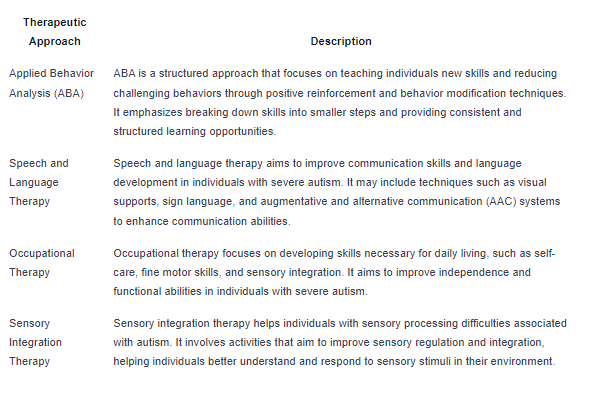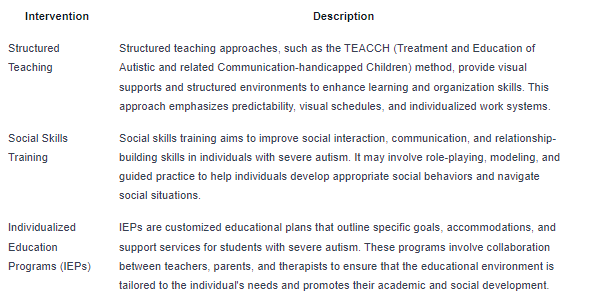Severe Autism: Understanding Level 3 Autism
Unraveling severe autism: Understand level 3 autism, its challenges, and the support available for individuals and families.

Understanding Severe Autism (Level 3)
In the realm of autism spectrum disorder (ASD), level 3 autism, also known as severe autism, represents a significant impairment in social communication skills and restrictive, repetitive behaviors. It is essential to gain a comprehensive understanding of level 3 autism to provide effective support and interventions for individuals with this condition.
Defining Level 3 Autism
Level 3 autism is characterized by substantial impairments in both verbal and nonverbal social communication skills. Individuals with level 3 autism often struggle with initiating and maintaining social interactions, understanding nonverbal cues, and expressing their own thoughts and feelings. They may show limited interest in others and have difficulty developing and maintaining relationships.
Furthermore, level 3 autism is associated with significant challenges in the domain of restrictive, repetitive behaviors. Individuals with severe autism may engage in repetitive movements, have highly focused interests, and exhibit inflexible adherence to routines. These behaviors can significantly impact their daily functioning and may interfere with their ability to adapt to new situations.
Characteristics and Challenges of Severe Autism
Severe autism is characterized by a range of challenges that individuals may experience. Some common characteristics and challenges associated with level 3 autism include:
- Impaired Social Interaction: Individuals with severe autism often struggle to engage in reciprocal social interactions, such as making eye contact, engaging in back-and-forth conversations, and understanding social cues.
- Limited Communication Skills: Communication difficulties are a hallmark of level 3 autism. These individuals may have limited verbal language skills or may be nonverbal altogether. They may rely on alternative communication methods, such as gestures, pictures, or augmentative and alternative communication (AAC) devices.
- Sensory Sensitivities: Many individuals with severe autism have heightened sensory sensitivities. They may be highly sensitive or hypo-responsive to certain sensory stimuli, such as noise, light, touch, or textures. These sensitivities can significantly impact their daily activities and may lead to sensory overload or withdrawal.
- Behavioral Challenges: Individuals with level 3 autism may exhibit challenging behaviors, such as self-injury, aggression, or tantrums. These behaviors can serve as a way to communicate their needs or may be a response to overwhelming sensory input or difficulties in understanding and expressing emotions.
- Intellectual and Developmental Disabilities: Along with the core symptoms of autism, individuals with severe autism often have intellectual and developmental disabilities. They may have significant cognitive impairments and may require support in areas such as academic learning, adaptive skills, and independent living.
Understanding the defining characteristics and challenges of level 3 autism is crucial for implementing appropriate support strategies and interventions. By recognizing the unique needs and strengths of individuals with severe autism, we can work towards enhancing their quality of life and promoting their overall well-being.
Diagnosing Severe Autism
When it comes to diagnosing severe autism, professionals follow specific criteria and procedures to assess an individual's symptoms and determine the severity of their condition. This section will explore the diagnostic criteria for Level 3 Autism and the assessment and evaluation process involved.
Diagnostic Criteria for Level 3 Autism
Level 3 Autism, also known as severe autism, is characterized by significant impairments in communication, social interaction, and restricted repetitive behaviors. To diagnose Level 3 Autism, professionals refer to the criteria outlined in the Diagnostic and Statistical Manual of Mental Disorders (DSM-5). Some key criteria for Level 3 Autism include:
- Social Communication: Individuals with Level 3 Autism demonstrate severe deficits in social communication skills. They may have limited or no verbal communication abilities and struggle to initiate or maintain social interactions.
- Restricted and Repetitive Behaviors: Level 3 Autism is marked by highly repetitive, stereotyped behaviors and intense resistance to change. These behaviors can significantly impact an individual's daily functioning and interfere with their ability to adapt to new situations.
- Functional Limitations: Severe autism is associated with substantial impairments in adaptive functioning. Individuals often require significant support to perform daily tasks and may have difficulties with self-care, independent living, and academic or occupational functioning.
It's important to note that a comprehensive evaluation conducted by a qualified professional is necessary to determine whether an individual meets the diagnostic criteria for Level 3 Autism.
Assessment and Evaluation Process
The assessment and evaluation process for severe autism involves a multidisciplinary approach to gather information about an individual's developmental history, behavior patterns, and communication abilities. This comprehensive evaluation helps professionals make an accurate diagnosis and develop appropriate intervention strategies. The process typically includes:
- Medical Evaluation: A thorough medical examination is conducted to rule out any underlying medical conditions that may contribute to the individual's symptoms. This evaluation may involve genetic testing, neurological assessments, and other medical investigations.
- Developmental History: Gathering information about the individual's developmental milestones, early childhood experiences, and any concerns raised by parents or caregivers helps in understanding the individual's developmental trajectory and identifying potential red flags.
- Observation and Behavioral Assessment: Professionals observe the individual's behavior in various settings to assess their social interactions, communication skills, and the presence of restricted and repetitive behaviors. Standardized assessment tools may be used to gather quantitative data for a more comprehensive evaluation.
- Communication Assessment: Assessing an individual's communication abilities is crucial in diagnosing severe autism. Professionals evaluate receptive and expressive language skills, nonverbal communication, and the use of gestures or alternative communication methods.
- Collaboration with Parents and Caregivers: Input from parents and caregivers is invaluable in understanding the individual's behaviors, challenges, and strengths. Collaborative discussions help professionals gain a holistic perspective and ensure that the evaluation process considers the individual's unique experiences.
By following these diagnostic criteria and conducting a thorough assessment, professionals can accurately diagnose Level 3 Autism and develop tailored intervention plans to support individuals with severe autism in their journey towards growth and development.
Behavioral Patterns and Communication
Understanding the behavioral patterns and communication challenges associated with severe autism (Level 3) is crucial in providing appropriate support and interventions. In this section, we will explore the behavioral challenges individuals with severe autism face and discuss communication difficulties along with some strategies to enhance communication.
Behavioral Challenges in Severe Autism
Individuals with severe autism often exhibit a range of behavioral challenges that can significantly impact their daily lives. These challenges may include:
- Stereotyped or Repetitive Behaviors: People with severe autism may engage in repetitive movements, such as hand flapping, rocking, or spinning objects. These behaviors can serve as a way to self-regulate or provide sensory stimulation.
- Restricted Interests and Routines: Individuals with severe autism may develop intense interests in specific topics or engage in rigid routines. They may become highly focused on particular objects, activities, or subjects and may struggle with changes to their established routines.
- Aggressive or Self-Injurious Behaviors: Some individuals with severe autism may display aggressive behaviors towards themselves or others. This can include hitting, biting, or head-banging. These behaviors can stem from frustration, sensory overload, or difficulty communicating their needs.
- Sensory Sensitivities: Many individuals with severe autism experience sensory sensitivities. They may be highly sensitive to certain sounds, lights, textures, or smells, which can lead to distress or meltdowns.
Understanding and addressing these behavioral challenges requires a personalized approach that takes into account the individual's unique needs and preferences. Behavioral interventions, such as Applied Behavior Analysis (ABA) or Positive Behavior Support (PBS), can be effective in promoting positive behaviors and reducing challenging behaviors in individuals with severe autism.
Communication Difficulties and Strategies
Communication difficulties are a significant aspect of severe autism. Many individuals with Level 3 autism struggle with spoken language, social interaction, and nonverbal communication. Some common communication challenges include:
- Limited Verbal Language: Individuals with severe autism may have limited or no verbal language skills. They may struggle to express their needs, emotions, or thoughts using words.
- Difficulty with Social Communication: People with severe autism often find it challenging to engage in reciprocal conversations or understand social cues. They may have difficulty understanding nonverbal communication, such as facial expressions or body language.
- Literal Understanding: Individuals with severe autism tend to have a literal understanding of language and may struggle with abstract concepts, idioms, or sarcasm.
- Augmentative and Alternative Communication (AAC): AAC systems, such as picture exchange communication systems (PECS) or speech-generating devices, can be beneficial for individuals with severe autism who have limited verbal language. These systems provide alternative ways to communicate their needs, desires, and thoughts.
To enhance communication in individuals with severe autism, it is essential to implement strategies tailored to their specific needs. These strategies may include visual supports, social stories, visual schedules, and using clear and concise language. Speech therapy and occupational therapy can also play a vital role in improving communication skills and addressing sensory sensitivities.
By understanding the behavioral challenges and communication difficulties associated with severe autism, we can create an environment that supports individuals with Level 3 autism and promotes their overall well-being and quality of life.
Support and Interventions
When it comes to supporting individuals with severe autism (Level 3), a range of therapeutic approaches and interventions can be beneficial in improving their quality of life and promoting their development. In this section, we will explore two key types of interventions: therapeutic approaches and behavioral and educational interventions.
Therapeutic Approaches for Level 3 Autism
Therapeutic approaches for individuals with Level 3 autism focus on addressing their unique needs and challenges through specialized interventions. These approaches often involve a multidisciplinary team of professionals, including psychologists, speech therapists, occupational therapists, and behavior analysts. The goal is to provide comprehensive support that targets various areas of development.
Some commonly used therapeutic approaches for Level 3 autism include:

These therapeutic approaches are tailored to the individual's specific needs and are often implemented in a structured and consistent manner. The duration and intensity of therapy may vary depending on the individual's progress and goals.
Behavioral and Educational Interventions
Behavioral and educational interventions play a crucial role in supporting individuals with severe autism. These interventions focus on addressing behavioral challenges and promoting learning and skill development.
Some common behavioral and educational interventions used for Level 3 autism include:

Behavioral and educational interventions often involve close collaboration between educators, therapists, and families to create a consistent and supportive environment that fosters growth and progress.
By combining therapeutic approaches with behavioral and educational interventions, individuals with severe autism can receive comprehensive support that addresses their unique challenges and maximizes their potential for development and independence. It's important to work with professionals who specialize in autism to create an individualized plan that meets the specific needs of each individual.
Family and Caregiver Support
When it comes to severe autism (Level 3), providing support to families and caregivers is crucial. The challenges associated with severe autism can significantly impact the daily lives of those involved. In this section, we will explore coping strategies for families and the importance of resources and support networks.
Coping Strategies for Families
Families of individuals with severe autism often face unique challenges and may experience a range of emotions while navigating their journey. It's important for families to have coping strategies in place to help them manage and adapt to the demands of caring for a loved one with severe autism. Here are some strategies that can be helpful:
- Seek Emotional Support: Connecting with other families who are going through similar experiences can provide a sense of understanding and validation. Support groups, both online and offline, can offer a safe space to share experiences, exchange advice, and gain emotional support.
- Educate Yourself: Understanding more about severe autism and the specific needs of your loved one can empower you to advocate effectively and make informed decisions. Keeping up-to-date with research, attending workshops, and consulting professionals can contribute to your knowledge and confidence as a caregiver.
- Practice Self-Care: Taking care of yourself is essential to maintain your physical and mental well-being. Find time for activities that bring you joy and relaxation. Engaging in hobbies, practicing mindfulness, or seeking therapy can help reduce stress and prevent burnout.
- Build a Support Network: Reach out to family members, friends, and neighbors who can provide support and respite care. Building a network of trusted individuals can help share the caregiving responsibilities and provide a break when needed.
- Establish Routines: Creating structured routines can provide a sense of predictability and stability for both the individual with severe autism and the family. Clearly defined schedules can help manage daily activities and transitions, reducing stress and anxiety.
Remember, every family's experience with severe autism is unique, and it's important to find coping strategies that work for your specific situation. It's okay to seek help, ask for support, and prioritize your well-being as a caregiver.
Resources and Support Networks
Finding appropriate resources and support networks is essential for families and caregivers of individuals with severe autism. These resources can provide valuable information, guidance, and assistance throughout the journey. Here are some key resources and support networks to consider:

These resources and support networks can help families and caregivers access valuable information, connect with others in similar situations, and find services that can support their loved ones with severe autism.
By utilizing coping strategies and tapping into available resources and support networks, families and caregivers can navigate the challenges of severe autism more effectively and provide the best possible care for their loved ones.
Progress and Outlook
When it comes to severe autism, understanding the potential for growth and long-term outlook is crucial for individuals and their families. While level 3 autism presents significant challenges, it's important to recognize that there is still potential for development and progress.
Potential for Growth and Development
Individuals with severe autism have the potential to make progress and experience growth in various aspects of their lives. With appropriate support and interventions, they can enhance their communication skills, develop new coping strategies, and improve their overall quality of life.
It's important to remember that progress looks different for each individual with severe autism. Some may make significant strides in communication, while others may focus on developing essential life skills or reducing challenging behaviors. Progress should be celebrated at every stage, no matter how small.
Long-Term Outlook for Individuals with Severe Autism
The long-term outlook for individuals with severe autism can vary depending on various factors such as the level of support, early interventions, and individual strengths. While some individuals with severe autism may require lifelong support, others may be able to develop a level of independence that allows them to lead fulfilling lives.
It's crucial to emphasize that there is no one-size-fits-all outcome for individuals with severe autism. Each person's journey is unique, and their long-term outlook should be approached with an individualized and holistic perspective.
Supportive environments, ongoing therapies, and access to appropriate educational and vocational opportunities play a vital role in improving the long-term outcomes for individuals with severe autism. By providing a nurturing and inclusive environment, society can help individuals with severe autism reach their full potential and lead meaningful lives.
Understanding the potential for growth and the long-term outlook for individuals with severe autism is essential in promoting inclusivity, acceptance, and support for those affected by this condition. With the right resources and opportunities, individuals with severe autism can make progress, thrive, and contribute to their communities in their own unique ways.
Sources
https://www.verywellhealth.com/what-is-severe-autism-260044
https://www.verywellmind.com/what-to-know-about-severe-autism-6665725
https://www.medicalnewstoday.com/articles/325106
Similar articles
We’re here to help you

Our team is here to assist you in this process. Contact us for any assistance.
it’s easy to apply
We Accept Most Insurances
Our in-network insurance partnerships make ABA therapy more accessible to families throughout our service areas.







Our Insurance Process
We'll request your insurance details to help us verify your plan's coverage for ABA therapy. Once we've received this information, we'll walk you through your benefits, including copayments, deductibles and out-of-pocket maximums, so you know what to expect in advance.
Our team will then handle the preauthorization and all the necessary paperwork.
.svg)





















.jpeg)


































.jpeg)




.jpeg)







.jpeg)











.jpeg)
















